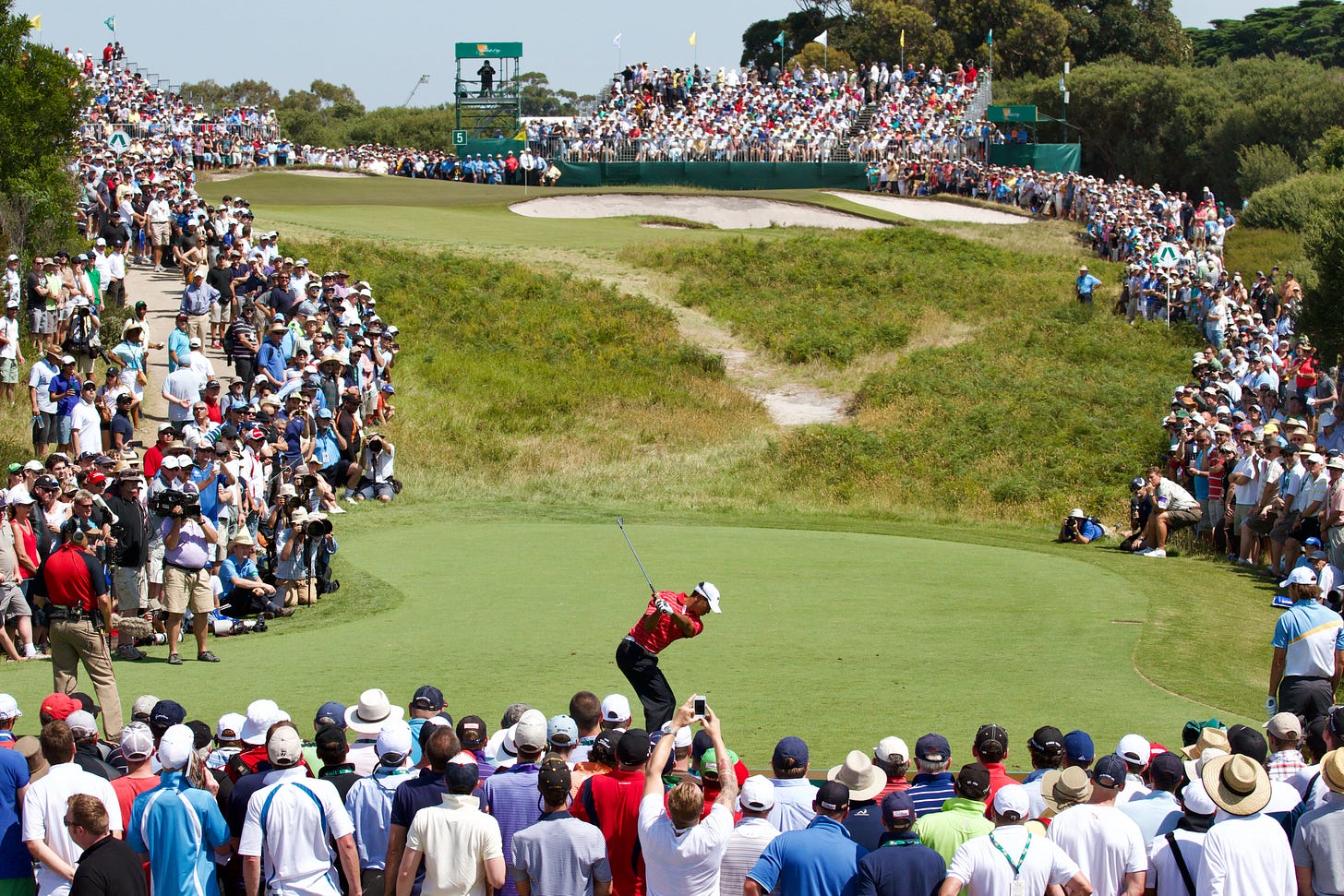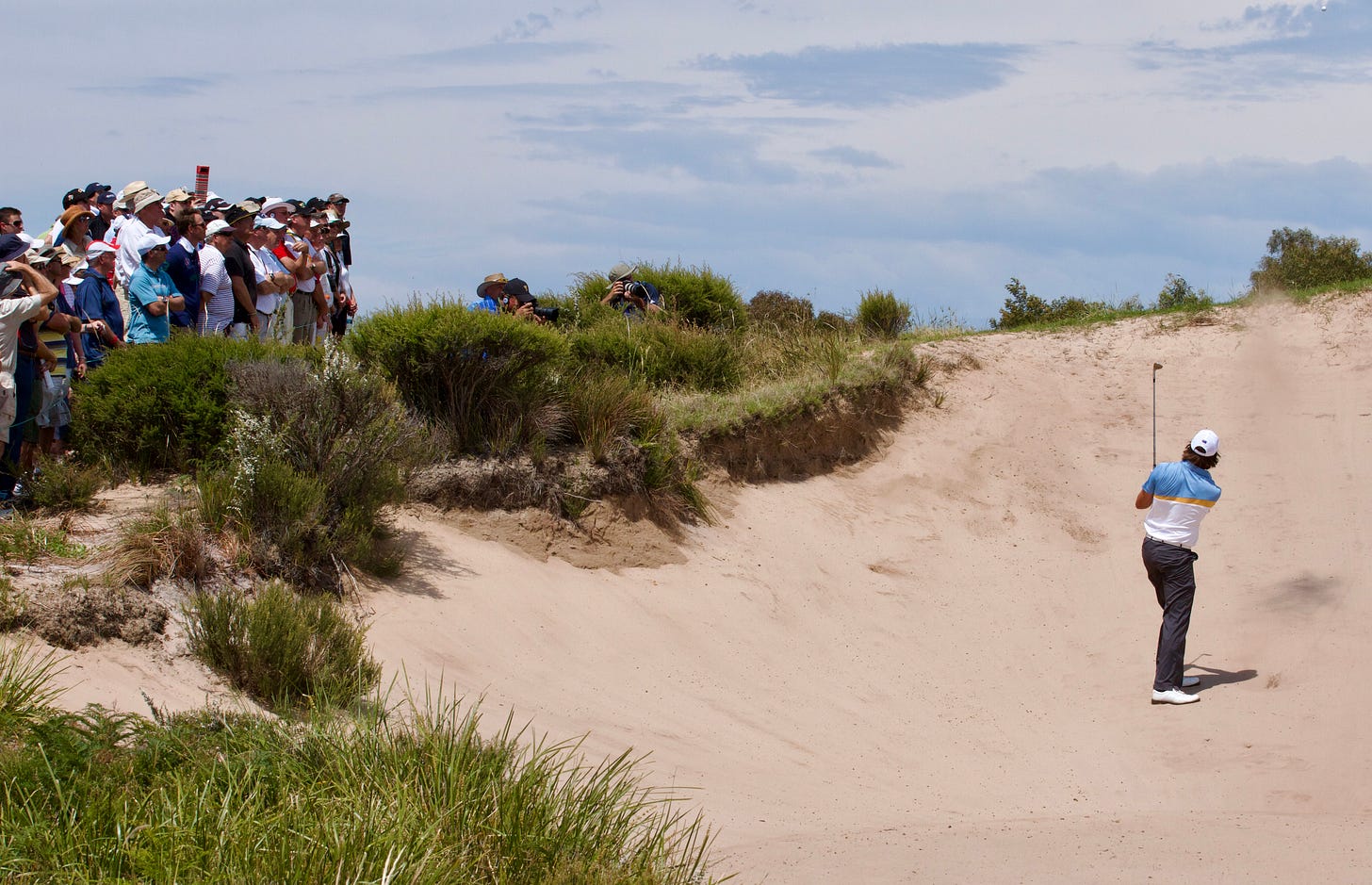Revisiting A Royal Melbourne Major
As the Asia Pacific Amateur Championship arrives at the Melbourne masterpiece, a look at what's changed since the PGA of America mulled international majors during Olympic years. Plus, an AAC preview.
Only 102 days separate the first round of the 2024 Masters from the last round of The Open at Royal Troon.
Throw in the Paris Olympics next August 1-4th, and the competition window for five international events expecting the world’s best to show up and perform at their best is just 116 days.
2024’s stretch of big time women’s golf is even more intense, particularly given the already international-heavy schedule they play (though still not announced for 2024. Give or take a week in final LPGA calculations, and the world’s best will be asked to play five majors and Olympic golf in a span of 123 days. One of the majors seemed a nice fit for a date change, yet France’s Amundi Evian Championship has announced a July 14th finish even though the Women’s Olympic golf opening round does not start until August 7th.
In contrast, men’s and women’s professional tennis will enjoy 239 days between the 2024 Australian Open first round and the U.S. Open men’s final. Olympic tennis slots in nicely after Wimbledon and before the U.S. Open.
Golf’s modern era sprints of intense championship golf are also surrounded by mandatory WGC elevated designated fancy-name-here “signature” events for the men and plenty of must-plays for the top women. The condensed schedule is built largely around avoiding American football and in the men’s game, to prop up the useless FedExCup “playoffs” that have managed to gain no momentum since being envisioned, re-imagined, retooled and repeatedly overhauled while being billed as the PGA Tour’s “Super Bowl.”
This is all a long-winded way of reminding you that the PGA Championship moved out of August to avoid conflicts with the Olympic Games every four years and to appease PGA Tour dreams of making the Playoffs© seem legitimate.
It has clicked as the parties predicted.
The PGA Championship held out hopes of becoming more than just a “last chance to win,” with dreams of a May date propelling the PGA of America’s golf instructors into the springtime spotlight when golfers are more apt to book a lesson. PGA’s in May were supposed to deliver better agronomics, weather and venue options than in sultry August.
Since the first edition in 2019 at Bethpage the May date has yet to deliver similar television ratings enjoyed when the PGA was the only major sports event in August. Venues have played fine in May, but it’s already been a close call agronomically after long winters prior to Bethpage, Southern Hills and Oak Hill. Only Kiawah improved under May conditions while the others were amazing testaments to wise superintendents and a little luck. And while not stated publicly, it appears Georgia and Florida courses are not a PGA option.
By following the Masters with late May dates, this has ruled out old PGA cashcows and successful weeks at your Hazeltine’s, Medinah’s and Bellerive’s, plus it seems, at least in unspoken Five Family terms, any venue near The Masters and The Players is out. Even the Pacific Northwest can be less than ideal in May, while Arizona is too hot and devoid of the wintertime residents who would support a championship. California’s prime coastal venues are likely to be foggy.
Harder to discern numerically: the U.S. Open impact now that under a month typically separates the two majors. But it sure feels like the U.S. Open build-up and anticipation is not what it used to be since the PGA moved to May.
Most of all, the four majors now feel excessively bunched into a tight window that may not be helping the Grand Slam weeks, the FedExCup or Olympic golf. The tight schedule may even be hurting.
Prior to the two PGA’s collaborating on this rescheduling trade, a typical year would have experienced around 125 days from the Masters’ opening shot to the PGA final round. That may not sound significantly better than 102 days, but the old Grand Slam slate felt far less condensed while giving the PGA more venues to choose from in golf New York, Pennsylvania, Illinois, Michigan and Minnesota.
When all of this was formulated, no shortage of observers suggested that instead of abandoning August to avoid Olympics conflicts, the PGA of America could take its championship abroad earlier in the year. The global “event” feeling of a PGA Championship leaving the United States every four years would catapult the PGA’s reputation internationally and confirm all that golf figurehead yammering about globalizing the sport. While it would be odd to start the year without The Masters going first (it will manage just fine), the PGA Championship has been played in nine different months since 2019’s May move. No one counts any of those randomly played PGA’s any differently on the list of majors won.
The obvious candidate to help free up the schedule in Olympic years would have been a February date in Australia to kick things off. The land Down Under offers the most appetizing potential given the obvious venue quality, a country crying out to host a golf major, and likely government support for something as monumental as a major. They put up $28,000,000 Australian dollars (almost $18 million) for the last Presidents Cup and that’s a tiny event compared to a men’s major.
Tennis’ Australian Open has thrived in January thanks to investment, innovations and the intangible perks of returning annually to magnificent Melbourne. Though if a suitable course could be found, a major in Asia would have had no trouble generating the revenue and excitement necessary to offset cost increases for the PGA and possible advertising hits for television partners. Japan has plenty of swell options.
This week’s Asia Pacific Amateur at Royal Melbourne will provide another reminder of what might have been. It’s also a good excuse to revisit the idea of going global every four years since schedules are in flux and so much has changed since then-PGA of America CEO Pete Bevacaqua and President Ted Bishop announced an inquiry into the global PGA possibilities in Olympic years.
“Part of our strategic plan is developing a global footprint,” Bevacqua said in 2014 when Harding Park was set to host the 2020 to provide date flexibility in an Olympic year. “It might not be something that we do right away, but it is absolutely something we continue to consider.”
Bevacqua has since moved from NBC to Notre Dame and Bishop has been ridiculously cancelled by his former organization over a genuine nothing burger. The Tokyo Games were postponed a year by the global pandemic. But the PGA study ultimately determined an international PGA would be too expensive for the organization. What utter and complete nonsense.
The Australian governmental support alone could have offset losses for the PGA and its television partners.
Since last discussed, the PGA of America has a new TV deal with CBS and ESPN (a network that solved the Australian Open issues and helped make the first tennis major bigger). The PGA of America now operates the KPMG Women’s PGA and CEO Seth Waugh has continued to preach the globalization theme, even rolling out the “World Alliance of PGA’s” to oppose a distance rollback in the name of growing the game. Ah, the irony. Lesson: the PGA of America can be a global entity when it suits their needs to keep receiving free golf balls from Fairhaven.
The PGA has also learned how much more international the women’s game is in makeup, popularity and sponsor interest. Coupling the two events together internationally makes as much sense as the making the Presidents Cup a mixed event. Only in this case the PGA isn’t answering to those weird Global Home forces. They can do this and no one will complain.
The USGA has already shown that there are benefits to conducting back-to-back men’s and women’s majors, with plans to repeat the Pinehurst success of 2014 again in 2029. And the IOC can’t move fast enough to combine men and women on teams, disciplines and competitions for many compelling reasons.
Which brings us to Australia, where they’re playing this week’s Asia Pacific Amateur at Royal Melbourne. The country and its wise Golf Australia team have given birth to several innovative tournament formats combining men and women’s events (Vic Open, 2022 Australian Open). This alone should be inspiration for the PGA of America, or would it be the World Alliance of PGA’s?
There would be undeniable cost savings of conducting back-to-back championships in the Sandbelt. It’s a market made for such a scenario from the quality of golf to the weather outside of April-to-August, to millions from government and corporate support. Most of all, going international would give the PGA Championship and Women’s PGA enormous reputational and prestige boosts that can never hurt. As nice as spreading out the schedule would be in this scenario to give players the best chance to put on a great show, the ultimate victors would be an organization taken at gunpoint screaming into a sound idea. Wouldn’t be the first time.
How would it have worked?
Taking 2024’s upcoming Olympic year as an example, two possible dates stand out for a February PGA and Women’s PGA. The first obvious opening arrives the week of February 1-4 after the tennis ends and the PGA Tour finishes the Torrey Pines event on a Saturday (a shrewd move that’s avoided finishing up against massive audiences watching the AFC and NFC Championship games). Playing the first week of February would allow players to fly late Saturday on a tournament-funded charter from San Diego, then enjoy a normal major week while the sports calendar is open during the pre-Super Bowl week. The women could play the following week and finish Saturday night before Super Bowl Sunday. (Ideally in one of these joint-event scenarios the women would actually get to play first, but that’s another story.)
“Divoting” has long been a concern of back-to-back full-field events, not to mention the potential agronomic strain caused by two weeks of pushing championship conditions. This is where Royal Melbourne and it’s generally impossible-to-injure, Claude Crockford-inspired turf stands a better chance than most courses. And with possibly the best 36-holes on the planet, select holes could be substituted in to help if landing areas with too many unrepaired divots are a concern. (Don’t tell the real world that golf makes decisions over divots, please?)
Option two: an appetizing late February date allowing for the Australian Open tennis buzz to wear off but before Australia’s traditional date with F1 Grand Prix racing. Royal Melbourne would still offer peak fast-and-firm conditions. And players could finish the Genesis at Riviera, hop on a plane, and if the turnaround to prep for a major is deemed too fast, the PGA could finish this rare one-off on a Monday. That would create a late Sunday night finish in the United States. And crowds would still show up in Melbourne. Remember, Australia’s biggest horse race is annually held on a Tuesday. They’re used to major events on weekdays.
Assuming this only happens once every four or eight years depending on where the Olympics are played, such scheduling quirks are not a big deal given the upside of taking more major championship world outside of the United States, the United Kingdom and France. The later February date option could also allow the women to play the Women’s PGA first during Genesis week. The hours would not be the same, giving them a prime time spotlight. Plus, a Friday start the following week for the men would give the course an extra day to recover from the Women’s PGA.
Returning to the buzzkill 2024 schedule, here’s what the PGA Tour schedule looks like: a “signature” event at Riviera followed by the “Mexico Open at Vidanta” and what is now being called in the clunkiest title ever, “The Classic In The Palm Beaches.” (Sources say West Palm can get very touchy about not being included in placeholder tournament titles.)
The logistical and philosophic issues surrounding the idea of an international event are all solvable compared to the tiresome questions about cost, revenue and the needs of media partners. The recent Rome Ryder Cup and other tournaments in places not normally used to big time golf—see the LIV event in Adelaide—should make this all seem like a risk worth taking to less-nimble organizations like the PGA of America. Especially now that they seem to have a great media partnership with CBS and ESPN. It’s arguably the best in golf given the turnaround and effort to upgrade the telecasts.
And by now everyone should know these one-off events may create more work but the upside for all sides is massive. Though if network partners can’t make this work to their liking, they can be compensated for losses not built into the contract and made up for by Australian government support. That said, the 2019 Presidents Cup from Royal Melbourne was a ratings hit.
And if the PGA Tour can’t switch around a Mexico Open or a Classic In The Palm Beaches for their lock-step partners in Frisco, then something is seriously wrong down at the Global Home (where the Players Championship return to March has also not delivered a sense of success or decent spring weather in Ponte Vedra after the solid run in May).











